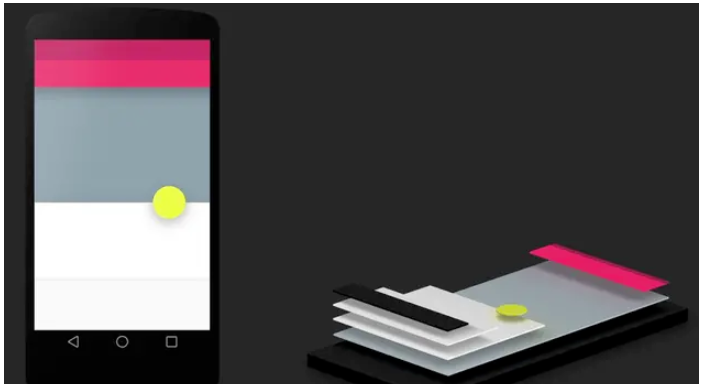您好,登錄后才能下訂單哦!
您好,登錄后才能下訂單哦!
這篇文章主要介紹了Android怎么實現陰影效果的相關知識,內容詳細易懂,操作簡單快捷,具有一定借鑒價值,相信大家閱讀完這篇Android怎么實現陰影效果文章都會有所收獲,下面我們一起來看看吧。
Material Design提供了View的陰影效果設置。主要由兩個屬性決定:elevation和translationZ。
Z = elevation + translationZ
PS:這種實現方式只有API21以及以上才能支持實現。
elevation屬性表示View高度加上高度就會有陰影效果。 translationZ屬性表示給View增加一個Z軸的變換效果。配合elevation屬性一起使用陰影效果更突出。
<androidx.appcompat.widget.LinearLayoutCompat android:layout_margin="15dp" android:layout_width="match_parent" android:layout_height="100dp" android:background="@android:color/holo_blue_bright" android:elevation="10dp" android:translationZ="10dp" android:paddingBottom="10dp" />

官網介紹

CardView是Android提供的官方控件自身支持設置陰影效果。陰影實現由cardElevation和cardMaxElevation實現。
<androidx.cardview.widget.CardView android:layout_margin="15dp" android:layout_width="match_parent" android:layout_height="100dp" android:outlineAmbientShadowColor="@android:color/holo_blue_bright" android:outlineSpotShadowColor="@android:color/holo_red_dark" app:cardElevation="5dp" app:cardMaxElevation="10dp" />

若是TextView則可以通過shadow屬性實現陰影效果
<TextView android:id="@+id/test_shadow" android:layout_gravity="center" android:layout_height="wrap_content" android:layout_width="wrap_content" android:shadowColor="#aa22ff22" android:shadowDx="0" android:shadowDy="0" android:shadowRadius="10" android:text="Test Shadow" android:textColor="#cc000000" android:textSize="60sp" />
通過配置xml的layer屬性文件實現陰影效果。使用layer-list實現兩層不同背景色實現疊加實現像是陰影的效果,但最終實現效果并不是例如CardView的漸變陰影效果。
<?xml version="1.0" encoding="utf-8"?> <layer-list xmlns:android="http://schemas.android.com/apk/res/android"> <!-- 陰影圖片,android:left表示陰影圖片左邊到背景圖片左邊的距離 android:top表示陰影圖片上邊到背景圖片上邊的距離--> <item android:left="5dp" android:top="5dp"> <shape> <solid android:color="#60000000"/> </shape> </item> <!-- 背景圖片,android:right表示陰影圖片右邊到背景圖片右邊的距離 android:bottom表示陰影圖片下邊到背景圖片下邊的距離--> <item android:bottom="5dp" android:right="5dp"> <shape> <solid android:color="#000000"/> </shape> </item> </layer-list>

自定義形式是通過自定義Drawable實現,該形式實現目標View必須關閉硬件加速。自定義Drawable主要通過重寫draw方法繪制矩形或圓形形狀增加陰影效果。
@Override
public void draw(@NonNull Canvas canvas) {
if (mBgColor != null) {
if (mBgColor.length == 1) {
mBgPaint.setColor(mBgColor[0]);
} else {
mBgPaint.setShader(new LinearGradient(mRect.left, mRect.height() / 2, mRect.right,
mRect.height() / 2, mBgColor, null, Shader.TileMode.CLAMP));
}
}
if (mShape == SHAPE_ROUND) {
canvas.drawRoundRect(mRect, mShapeRadius, mShapeRadius, mShadowPaint);
canvas.drawRoundRect(mRect, mShapeRadius, mShapeRadius, mBgPaint);
} else {
canvas.drawCircle(mRect.centerX(), mRect.centerY(), Math.min(mRect.width(), mRect.height())/ 2, mShadowPaint);
canvas.drawCircle(mRect.centerX(), mRect.centerY(), Math.min(mRect.width(), mRect.height())/ 2, mBgPaint);
}
}| 實現方式 | 優缺點 |
|---|---|
| elevation | 優點:自帶功能實現簡單 缺點:不可自定義顏色 |
| CardView | 優點:自帶功能實現簡單 缺點:自帶圓角不一定可適配所有需求 |
| Textshadow | 優點:自帶功能實現簡單 缺點:只可在TextView中使用 |
| layer | 優點:實現形式簡單 缺點:效果一般 |
| 自定義實現 | 優點:實現效果好可配置能力高 缺點:需要開發者自行開發 |
關于“Android怎么實現陰影效果”這篇文章的內容就介紹到這里,感謝各位的閱讀!相信大家對“Android怎么實現陰影效果”知識都有一定的了解,大家如果還想學習更多知識,歡迎關注億速云行業資訊頻道。
免責聲明:本站發布的內容(圖片、視頻和文字)以原創、轉載和分享為主,文章觀點不代表本網站立場,如果涉及侵權請聯系站長郵箱:is@yisu.com進行舉報,并提供相關證據,一經查實,將立刻刪除涉嫌侵權內容。